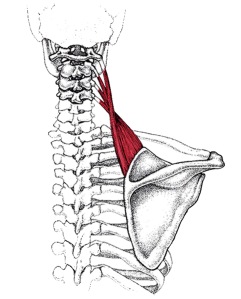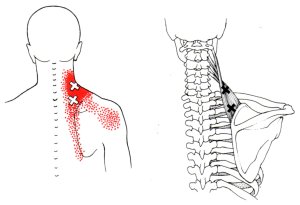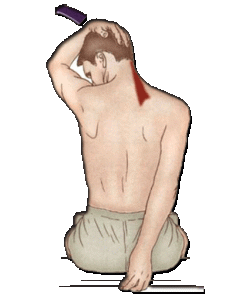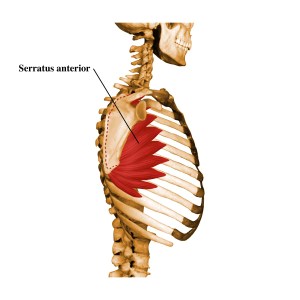The levator scapular muscle is one little nasty muscle that may cause us problems from time to time, especially for those who spend a lot of time at a desk, looking down at their tablets or phones, or laying on pillows that are too high for their bodies – just to name a few common activities.
When the levator scapular muscle becomes shortened and tight, it can develop little contractures in between the muscle fibres, called trigger points. The result of these trigger points forming will create pain in the location of the little contractures or may refer pain to certain areas of the body.
The trigger points of the levator scapular muscle are shown, and its associated referral pattern:
So if you have ever wondered why parts of your body may feel heavy, achy or it has a strange sensation but you just don’t know where the source of the problem is coming from, you may want to know some common trigger point locations and its pain referral pattern.
As the above image suggests, the referral pattern of the levator scapular trigger points is to the back of the shoulder and along the edge of the scapular bone near our spine, the medial spine of the scapula. Another association with levator scapular syndrome is mechanical dysfunction of the upper cervical spine at either C1, C2, C3 or C4 where the muscle inserts. What is meant by mechanical dysfunction is the inability of the joint to move freely in its full range of motion without any hindrances from muscular pain, tightness or joint restrictions.
Hence, we could either view the mechanical dysfunction in two ways:
1. the joints of C1, C2, C3 or C4 is not moving properly causing the levator scapular muscle to spasm, tighten or shorten
2. The spasming of levator scapular muscle causes the joints of C1, C2, C3 or C4 to be dysfunctional
How to treat levator scapular syndrome:
– trigger point therapy: you can use a lacrosse ball/massage ball/tennis ball (a ball that is rather firm so you can apply pressure against it) and place the ball onto the location of the trigger point and roll the ball around the area; or apply static pressure to the point until the tenderness/referral pain completely dims down
– muscle stretches: to stretch the levator scapular muscle, follow the image below. The proper way to stretch is to hold the muscle in its stretch position until you don’t feel the stretching sensation anymore. Holding the muscle in a stretch position is a static stretch. You could also do an active stretch where you take the muscle to its stretching position and then go through the range of motion of the muscle, whilst maintaining the stretch tension, until you feel the stretching sensation diminish.
– cervical adjustments by a Chiropractor: having your chiropractor assess your posture, your daily activities and your compensation patterns will enable a clear diagnosis of the causes and effects of what is happening with your body. Your chiropractor will be able to determine the level of mechanical joint dysfunction in your cervical spine and then adjust the dysfunctional segment to restore proper range of motion, thus eliminating one cause of levator scapular syndrome.
– eliminating contributing factors/postures: shoulder shrugging regularly recruits the levator scapular muscle. So, it is very important to have your desk height at a level where your shoulders are dropped down and backwards in a relaxed state to prevent shoulder shrugging. Eliminating stress is also a very important factor to eliminate when treating levator scapular syndrome because when we stress, we automatically assume a position where our shoulders are elevated and held there to hold in our tension.
– strengthening exercises of the antagonist muscles: antagonist muscles are muscles that act to oppose the function of another muscle. The antagonist muscle of the levator scapular muscle are the serratus anterior and middle trapezius muscles.
Strengthening the antagonist muscles will be able to counteract the force of the problem muscle, in this case the levator scapular, by balancing out the power of the muscle and its associated pull on its bony attachments
strengthen the middle trapezius:
Rehabilitation exercises to Rehabilitation exercises to strengthen the serratus anterior:
If you are still unsure, please get a consultation from your Chiropractor to get properly assessed and treated.





